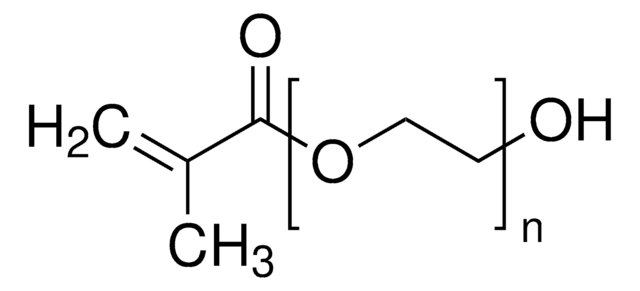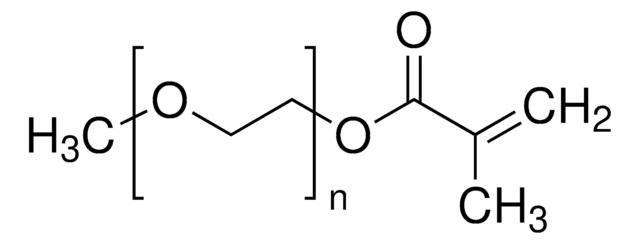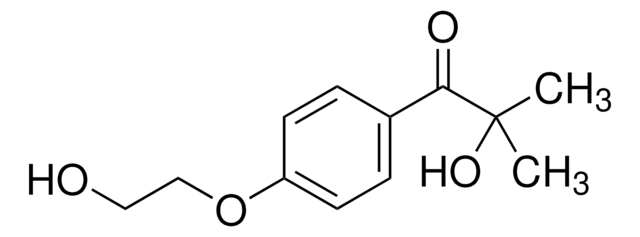409510
Poly(ethylene glycol) dimethacrylate
average MN 550, cross-linking reagent polymerization reactions, methacrylate, 80-120 ppm MEHQ as inhibitor, 270-330 ppm BHT as inhibitor
동의어(들):
Polyethylene glycol, PEG dimethacrylate
About This Item
추천 제품
제품명
Poly(ethylene glycol) dimethacrylate, average Mn 550, contains 80-120 ppm MEHQ as inhibitor, 270-330 ppm BHT as inhibitor
양식
liquid
Quality Level
분자량
average Mn 550
포함
270-330 ppm BHT as inhibitor
80-120 ppm MEHQ as inhibitor
반응 적합성
reagent type: cross-linking reagent
reaction type: Polymerization Reactions
refractive index
n20/D 1.466
bp
>200 °C/2 mmHg (lit.)
density
1.099 g/mL at 25 °C
Ω-끝
methacrylate
α-끝
methacrylate
폴리머 구조
shape: linear
functionality: homobifunctional
저장 온도
2-8°C
SMILES string
OCCO.CC(=C)C(O)=O
InChI
1S/C10H14O4/c1-7(2)9(11)13-5-6-14-10(12)8(3)4/h1,3,5-6H2,2,4H3
InChI key
STVZJERGLQHEKB-UHFFFAOYSA-N
유사한 제품을 찾으십니까? 방문 제품 비교 안내
애플리케이션
- PDGF-AA loaded photo-crosslinked chitosan-based hydrogel for promoting wound healing.: This study investigates the use of a chitosan-based hydrogel, photo-crosslinked with Poly(ethylene glycol) dimethacrylate (PEGDMA), to deliver PDGF-AA and enhance wound healing. The results demonstrate significant improvements in wound closure rates and tissue regeneration (Cai et al., 2024).
- Reducing the foreign body response on human cochlear implants and their materials in vivo with photografted zwitterionic hydrogel coatings.: This research explores the application of PEGDMA in zwitterionic hydrogel coatings to minimize foreign body responses in cochlear implants. The coatings significantly reduced inflammation and improved biocompatibility in vivo (Horne et al., 2023).
- Full factorial design of experiment-based and response surface methodology approach for evaluating variation in uniaxial compressive mechanical properties, and biocompatibility of photocurable PEGDMA-based scaffolds.: This study uses a full factorial design to optimize the mechanical properties and biocompatibility of PEGDMA-based scaffolds, highlighting their potential use in tissue engineering and regenerative medicine (Bharadwaz et al., 2023).
- Antifouling and Mechanical Properties of Photografted Zwitterionic Hydrogel Thin-Film Coatings Depend on the Cross-Link Density.: This article examines how varying the cross-link density in PEGDMA-based hydrogel coatings affects their antifouling and mechanical properties. The findings are relevant for the development of durable and biocompatible medical device coatings (Jensen et al., 2021).
- Biocompatible and photocrosslinkable poly(ethylene glycol)/keratin biocomposite hydrogels.: The research presents the development of PEGDMA/keratin biocomposite hydrogels, demonstrating excellent biocompatibility and potential applications in drug delivery systems and tissue engineering (Wang et al., 2021).
Storage Class Code
10 - Combustible liquids
WGK
WGK 1
Flash Point (°F)
Not applicable
Flash Point (°C)
Not applicable
이미 열람한 고객
문서
Patterning of PEG-based Hydrogels - Engineering Spatial Complexity
Devising biomaterial scaffolds that are capable of recapitulating critical aspects of the complex extracellular nature of living tissues in a threedimensional (3D) fashion is a challenging requirement in the field of tissue engineering and regenerative medicine.
Global Trade Item Number
| SKU | GTIN |
|---|---|
| 409510-1L | 4061831989328 |
| 409510-250ML | 4061831989335 |
자사의 과학자팀은 생명 과학, 재료 과학, 화학 합성, 크로마토그래피, 분석 및 기타 많은 영역을 포함한 모든 과학 분야에 경험이 있습니다..
고객지원팀으로 연락바랍니다.







